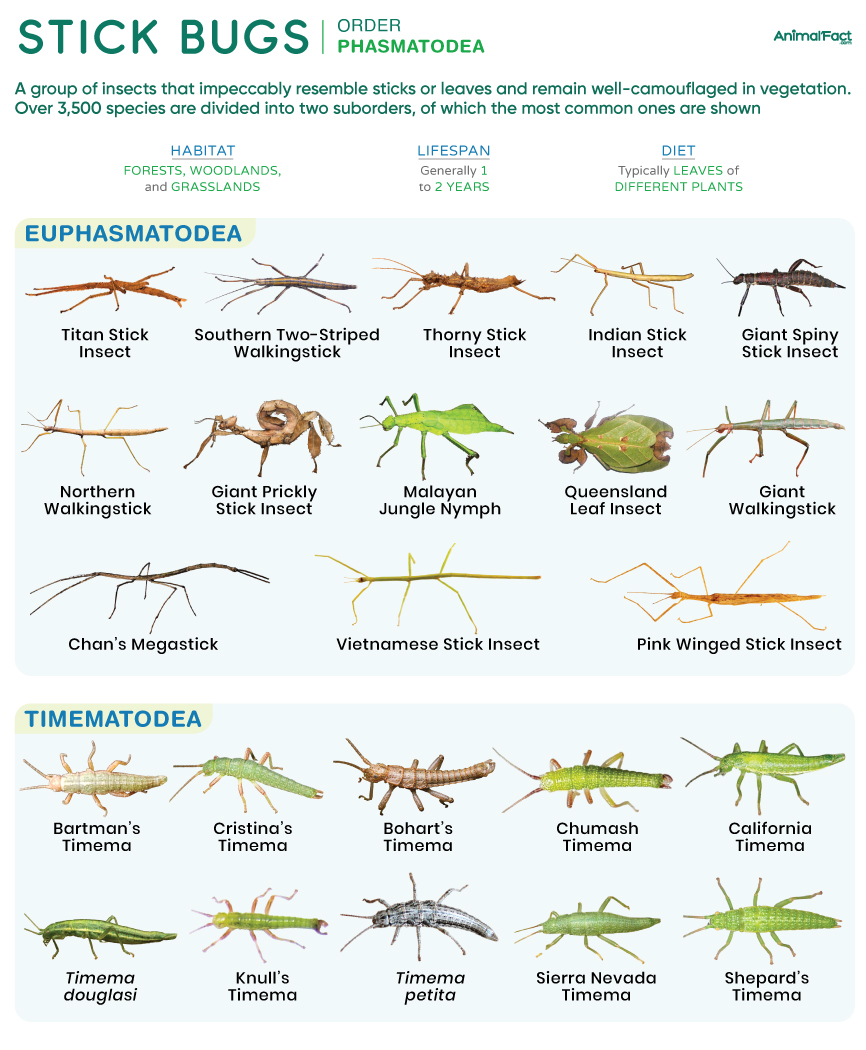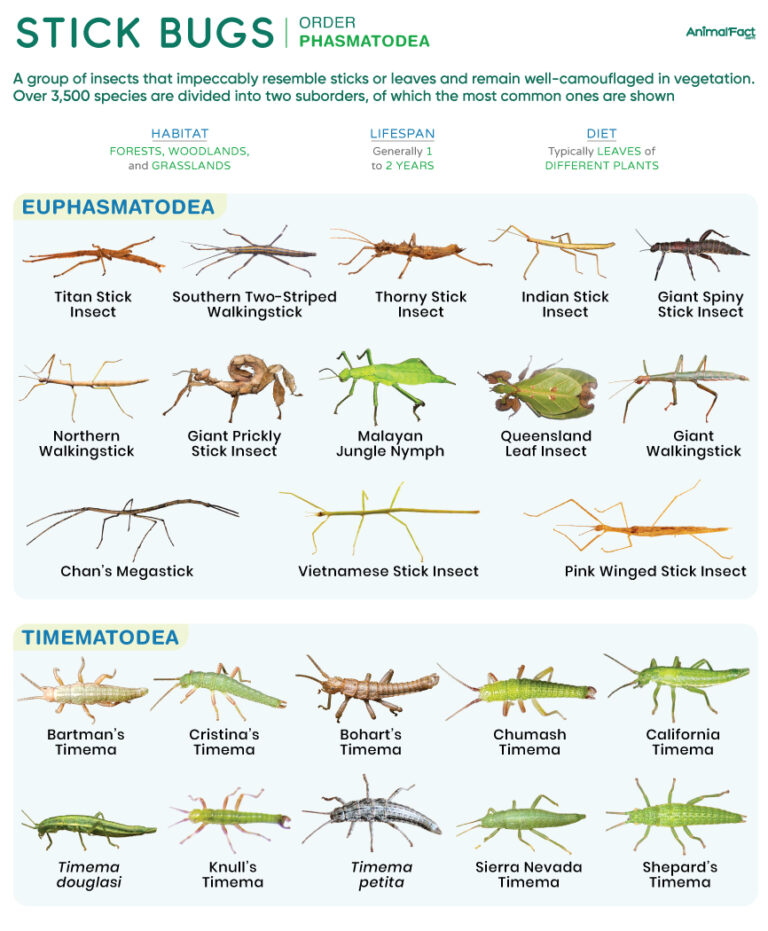


Stick bugs, also commonly called stick insects, walking sticks, stick animals, phasmids, ghost animals, or phasmatodeans, are insects of the order Phasmatodea. As their name implies, these insects may be either cylindrical and stick-like or flat and leaf-like, shapes that help them blend with the surrounding vegetation (crypsis). Most stick bugs are wingless, but a few species have wings. However, their capacity to fly over long distances is typically low.

Although particularly abundant in the tropics, these insects are found almost on all continents, except Antarctica and the Patagonian region of South America (the southern parts of Argentina and Chile). Over 3,500 species of stick bugs have been described worldwide.
Most species measure between 1 and 12 in (2.5 and 30 cm). However, the longest stick insect, which also happens to be the longest insect in the world, is Phryganistria “chinensis”, a yet-undescribed species that measures 24.6 in (62.4 cm) in total length (including extended legs).[1]
Adults of one of the smallest species, Cristina’s timema (Timema cristinae), are only about 0.7 to 1.1 in (2 to 3 cm) long.
As insects, stick bugs have a tripartite body, divided into three distinct segments: the head, thorax, and abdomen.
Depending on the species, the head is rounded or slightly elongated. It bears a pair of slender, multi-segmented antennae and a pair of compound eyes, with smaller simple eyes (ocelli) in members of Lanceocercata, Necrosciinae, Pseudophasmatidae, Palophidae, and Phylliidae. Females of only the first three groups bear ocelli.
They have chewing-type mandibles adapted for consuming plant matter. Specialized sensory appendages, the maxillary and labial palps, help in tasting and manipulating food, later guiding it into the mouth.
The thoracic region is subdivided into three segments: pro-, meso, and metathorax. The prothorax, the shortest of the three segments, bears the first pair of legs, while the mesothorax, typically the longest of the three, bears the second pair of legs and the forewings (if present). The metathorax bears the third pair of legs and the hindwings (if present).
Around 60% of all stick bugs have significantly reduced wings or lack them altogether.[2] However, a few species, such as the Children’s stick insect (Tropidoderus childrenii), have both forewings and hindwings. The forewings are leathery and protective, whereas the hindwings are membranous.
The abdominal region typically has 10 visible segments, often thickened in females to bear eggs. Moreover, in females, the abdomen ends in an ovipositor used for laying eggs, while in males, it terminates in claspers that aid in gripping their mates during reproduction.
Phasmatodea was originally classified as a suborder within Orthoptera, but distinct anatomical differences eventually led scientists to recognize it as a separate, monophyletic group. As a result, Phasmatodea was assigned as an order.
Traditionally, this order was classified into two suborders, Anareolatae and Areolatae, although an alternate classification divided Phasmatodea into three suborders: Agathemerodea, Timematodea, and Euphasmatodea (or Verophasmatodea). However, molecular studies revealed that Agathemerodea is nested within Euphasmatodea. Thus, currently, only two suborders are accepted: Timematodea and Euphasmatodea.
Their highest species diversity occurs in the tropics and subtropics, particularly in Southeast Asia, South America, Australia, Central America, and the southern United States.[3] The Southeast Asian island of Borneo is home to over 300 species of stick insects, making it the region with the highest species richness of stick bugs in the world.
They are strictly herbivorous insects, feeding primarily on foliage from broadleaf plants, shrubs, and trees. Their preferred plants include blackberry, hazel, privet, and hawthorn, among others. The Indian stick insect (Carausius morosus) particularly feeds on the leaves of ivy.[4]
In captivity, stick bugs are fed on the leaves of raspberries, roses, and lettuce.
These insects are predominantly nocturnal, remaining active mostly during the night. While they stay camouflaged on tree leaves when at rest, they also attempt to blend in with their surroundings even while moving. Some species, such as Extatosoma tiaratum, perform a rocking motion to resemble the movement of leaves or twigs swaying in the wind.[5] This species has also been observed to curl its abdomen upwards over the body to resemble ants or scorpions. Others may enter a cataleptic state, where they stay motionless for prolonged periods.
Females of a few species, like Pterinoxylus spinulosus, extend their wings laterally, displaying vivid carmine coloration to fend off their predators. They also rub their wings to produce a grating sound (stridulation), with intermittent variations in intensity.[6]
Some species have been observed to regurgitate the contents of their stomach when threatened. They may also release hemolymph through their legs (autohaemorrhaging) to ward off their predators.[7]
Although lifespan varies with species, most stick bugs live for 1 to 2 years.
Although most stick bugs reproduce sexually, many resort to asexual reproduction through parthenogenesis.
Female stick bugs release chemical cues through sex pheromones to attract the males. Following the pheromone trail, the male finds the female and climbs on her back. He then grasps the female with claspers and aligns his body with hers. While copulating, he inserts his aedeagus into the female’s reproductive opening to transfer a spermatophore (packet of sperm). The female stores the sperm in her sperm-storing sac or spermatheca.
Depending on the species, the females may lay anywhere between 100 and 1,200 eggs. They may drop their eggs to the ground using their ovipositors, place them in the axils of the host plant, bury them in small soil pits, or even stick them to a particular substrate. These eggs are seed-like, with a lid-like structure called an operculum at one end.
In tropical regions, stick bugs breed year-round, although in the temperate zone, the females typically lay eggs in the autumn. The eggs generally hatch in 20 to 30 days.
As hemimetabolous insects, the eggs of stick bugs undergo multiple nymphal instars (typically 5 to 6 molts) before transforming into adults. At each nymphal instar, the insect eats its cast skin. In winged species, the wing buds gradually enlarge with each molt, with wings becoming fully developed and functional in the final instar. The final instar sheds its exuvia to become an adult.
Many species, such as Acanthoxyla inermis, are exclusively parthenogenetic, meaning the virgin females lay unfertilized eggs that develop into genetic clones or daughters.[8] Although this particular species lacks males in the population, some species may have them, thereby switching between sexual and asexual modes of reproduction.
Despite their exceptional camouflaging abilities, stick bugs are prone to predation by insectivorous birds, lizards, snakes, rodents, and other arthropods, such as spiders. Since these insects are primarily nocturnal, they become targets of bats, which easily detect them through echolocation.[9]